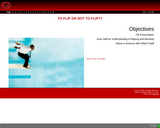
For teaching staff
- Subject:
- Education
- Material Type:
- Lecture Notes
- Date Added:
- 03/19/2018

For teaching staff
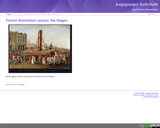
Background information for a simplified version of the "stages" of the French Revolution.
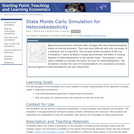
This is a simulation for a beginning econometrics course that shows students how heteroskedasticity biases an estimator and why the power of a statistical text is important.

Watch different types of molecules form a solid, liquid, or gas. Add or remove heat and watch the phase change. Change the temperature or volume of a container and see a pressure-temperature diagram respond in real time. Relate the interaction potential to the forces between molecules.
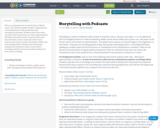
This is an assignment for an Introduction to Media course. The activity includes students comparing and contrasting historic radio productions and contemporary podcasts. Students then choose their own short story, essay, poem, etc. that is approximately 200-300 words and/or under 5 minutes when read aloud. Students create a transcript of their story selection and create an audio recording on Padlet.com, a free media platform. Students then share their readings with classmates, listen to each other's recordings and discuss several creative attributes of their audio recordings.
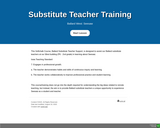
This Softchalk Course, Ballard Substitute Teacher Support, is designed to assist our Ballard substitute teachers at our West building (PK - 2nd grade) in learning about Seesaw.
Iowa Teaching Standard
7: Engages in professional growth.
a. The teacher demonstrates the habits and skills of continuous inquiry and learning.
b. The teacher works collaboratively to improve professional practice and student learning.
This course/training does not go into the depth required for understanding the big ideas related to remote teaching, but instead, the aim is to provide Ballard substitute teachers a unique opportunity to experience Seesaw as a student and teacher.

This is an instructional video demonstrating how to subtract integers using colored chips to visually represent the subtraction rule of adding the opposite.

Students will use a fictional Farmers Market Menu to solve word problems requiring the addition, subtraction, multiplication, and or division of decimals and whole numbers.

This lesson uses images and the "I See...and I Wonder" strategy to get students thinking about the bigger concepts that objects might represent. Students often see symbols as mere objects with only a only face value because of the speed with which they encounter them. However, if we can encourage students to take more time to study an object, other concepts or meanings can come to light.This lesson uses images as an entry point to symbolism because they are less threatening than literature. The images provided are a starting place, but feel free to remix and use your own images. This journaling activity is about writing (and discussing) to learn. It can be graded or just formative. Either way, items to assess would include:Do students really dig into the details, both large and small?Are they being thorough "readers" of the image in the quality of their "wondering"? There is no length requirement, but the timer recommendations do communicate an expectation that responses to be more than just a sentence or two or a very brief list.For task 2, do students begin to make some interpretive claims? Are those claims valid? Are they grounded in the details?If students are struggling to make interpretive claims that make sense with the image, back up and do another image in small groups that might allow more modeling, deeper thinking prompts, or even questioning the students to better understand their interpretations.If students are successful with the images, transition to a short peice of text like a poem. Students can use the same process of "I See...and I Wonder." The Task 2 questions can be slightly modified to apply to text rather than image.
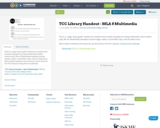
This is a 1-page "quick guide" handout for students that includes examples for citing multimedia in MLA citation style, 8th ed. Multimedia examples include images, videos, sound effect clips, and recorded music. More citation handouts and resources can be found on the TCC Library's Citing Sources LibGuide.
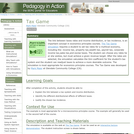
The link between a set of taxes and income distribution is an important, but difficult, concept taught in economics principles courses. The Tax Game simulation requires a student to set tax rates for an income tax, a property tax, a wealth tax, a payroll tax, a corporate income tax, a sales tax,and an excise tax. The student can choose any rates he or she wishes, but must achieve a given revenue target.

This lesson is to help teachers set up an account on Twitter and connect with other educators to grow personally and professionally.

This lesson is meant for teachers to use during a professional learning session around the science of reading. Teachers will read an article and reflect on it using the "Sentence - Phrase - Word" routine from Making Thinking Visible.
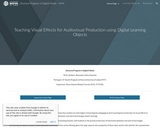
The research project of this Ph.D. in Digital Media has as objective the creation of a tool (object of learning) for pedagogical aid in teaching the production of visual effects in audiovisual productions, more specifically in the interactions between real and virtual images (match moving).
The prototype created during the research has the purpose of assisting teachers and students in the practical exercises of interaction between real and virtual images.
The tool has the ability to assist in data collection at the time of live-action filming, given the large amount and complexity of these data, and its vital need for the reproduction of real conditions in the virtual universe later.
In addition, it has the ability to generate a script (in Maxscript language) for its use in 3DS Max graphics software, automating part of the production process.
It is also part of the research, besides the conception and creation of the tool (learning object), its validation in the pedagogical and design bias (user experience and user interface).
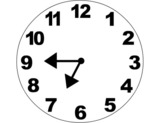
A quick lesson or center activity for telling time to the quarter hour. *photo courtesy of clipartbest.com

Students use pitch to explore the characters in a story.
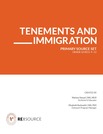
The primary sources in this set can be used for inquiry-based learning exercises and projects. Each document falls under the umbrella topic of tenements and immigration, and students are encouraged to annotate in the margins in order to support the development of document analysis and critical thinking skills. Suggested projects that make use of this set’s primary sources are also included for the educator as a springboard for research-based projects.
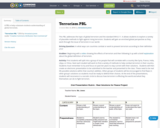
A PBL to help culminate students understanding of global terrorism.
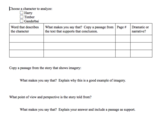
Whether freshmen or AP seniors, students often forget to back up their statements about texts with evidence for support or to begin with the text when considering answers to literary questions. The more we ask them to provide textual evidence in discussion, analysis activities, essays, and on tests, the more ingrained this important skill will become. This lesson was designed for freshmen at the beginning of the year as they begin analyzing literature. The handout and question refer specifically to the story "Poison" by Roald Dahl, but feel free to remix the lesson to work with another text, older students or nonfiction.

Students will be introduced into the basic theories of motivation. They will then dig deeper into one theory, think about it critically from varying perspectives, and compare and contrast their theory to other theories.